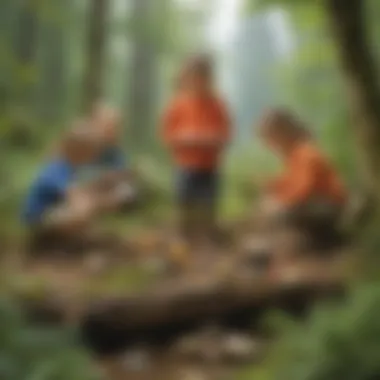Creative Outdoor Activities for Elementary Kids


Intro
Engaging children outdoors offers a rich environment for creativity, exploration, and social interaction. As youngsters age 5 to 12 take part in different activities outside, their pragmatic skills can flourish. The world is vast, and when children interact with nature, they embark on voyages of discovery. Not only do these creative outdoor activities stimulate artistic expression, they contribute immensely to emotional and physical development. This article outlines various practical activities suitable for elementary school children, aiming to provide parents and educators with activities that blend joy and education.
Creative Activities
Creative outdoor play is a significant part of childhood. Children can express themselves freely outside, without the confines of a classroom. Below are several activities designed to encourage exploration and creativity:
Craft Ideas
Crafting in nature serves dual purposes. Firstly, it connects artistic expression with the outdoors. For example, children can make leaf rubbings: – Simply collect leaves of different shapes and sizes. Lay a sheet of paper over the leaves, and use crayons to gently rub over the paper. This reveals unique patterns that children can contemplate.
Another engaging activity involves making nature collages. Supplies include items gathered from outside, such as twigs, leaves, and even stones. Children can glue these all together on larger paper, creating a personalized work of art to decorate at home.
Step-by-Step Guides
For a clear understanding of funny yet educational activities, it is critical to present steps simply. Let’s consider a classic activity: making a bird feeder. Here’s a succinct guide:
- Gather materials: Empty toilet paper rolls, peanut butter, and birdseed.
- Spread peanut butter evenly over the cardboard tube.
- Roll the peanut butter-covered tube in birdseed until it is well coated.
- Use string to hang it from a tree branch.
- Watch and enjoy as birds gather around.
This simple act instills patience and excitement as children observe the different birds that come to visit.
Educational Value
Incorporating creative outdoor activities nurtures essential skills in young learners.
- Observation skills improve as they explore and notice details in their surroundings.
- Collaboration and communication are enhanced when working with peers during activities.
- Problem-solving skills are naturally developed as challenges arise, whether from environmental conditions or negotiating among friends.
Engaging with nature is more than just fun. It marks an underlying foundation for their development.
Creativity, curiosity, and innovation bloom in a child's mind through regular outdoor activities.
Fun Quizzes
Quizzes can be a fun way to wrap up what children learnt during their exploration. Engaging quiz topics on creative arts or nature sciences target their knowledge base:
Quiz Topics
- Popular topics for quiz include:
- Famous artists and their topics;
- Different plant species found in local ecosystems;
- Basic animal facts about state wildlife.
Question Types
To keep engagement high, a variety of formats can be surprisingly useful:
- Multiple choice questions to choose the correct option;
- Fill-in-the-blank scenarios that require critical thinking;
- True or False statements that challenge misconceptions.
Knowledge Reinforcement
These quizzes serve not just as fun activities, they reinforce what children have begun to learn through practice and investigation. Each question prompts reflection and solidifies their newly acquired knowledge.
Fact-Based Articles
Last not least, accompanying materials enhance knowledge exploration by presenting facts in an engaging manner.
Topics
A broad array of topics presents intriguing avenues for further exploration. Children can read about insects, ecosystems, or even local/- tribal history alive through articles.


Engaging Content
These articles aim not just to inform. They utilize accessible language, visuals, and diverse means to maintain interest. Supporting photos and diagrams keeps comprehension on track while encouraging curiosity to sway deeper.
Prologue to Outdoor Creativity
Engaging with the outdoors plays a critical role in a child's development. As children transition from structured indoor environments to the outside world, they gain vital skills that define their creativity and everyday learning processes. Outdoor creativity involves giving children the freedom to explore, innovate, and create in a setting that is rich with stimuli. This article not only emphasizes various outdoor activities but also highlights the significance they hold in fostering connections between nature and children's imaginations.
Outdoor creativity serves various crucial functions in nurturing young minds. Unlike controlled indoor activities, the unpredictable nature of the outdoors encourages spontaneity and problem-solving. Children can engage with elements of the environment—trees, leaves, or gravel—turning these ordinary items into passionate games or art. All of these are effective tools for cognitive growth.
Some key benefits of outdoor creativity include:
- Development of Physical Skills: Activities like climbing, running, and jumping promote coordination, balance, and strength.
- Creative Expression: The outdoors offers endless options for artistic projects. Not only do materials vary widely, but children can also employ natural settings to enhance their visual storytelling.
- Social Skill Enhancement: Engaging in outdoor activities often involves collaboration, where children learn to communicate, negotiate, and work towards common goals.
- Connection to Nature: Exposure to nature has been linked to psychological well-being. Helping children understand their place within the environment instills greater appreciation for the world around them.
As one reflects on these benefits, it is clear that outdoor creativity holds significant value for children ages 5 to 12. Whether it be through organized games or personal explorations, such experiences extend learning beyond traditional elements. Educators and parents should consider structuring intentional time for creative outdoor play. By deliberately integrating these experiences into children's routines, one can expect holistic development of their physical, social, and emotional skills.
“Creative outdoor activities can facilitate multidimensional learning experiences that complement traditional education”
Through this article, the exploration of creative outdoor activities aims to inspire caregivers and educators alike, ultimately setting the stage for limitless imagination and exploration in a child's daily life.
Understanding Outdoor Play
Outdoor play is a fundamental aspect of child development. It allows young children to unleash their creativity while balancing physical activity and socialization. Engaging in outdoor activities facilitates healthy growth. It also provides a canvas for self-expression and imaginative play.
Defining Outdoor Play
Outdoor play simply means engaging children in activities outside. This can range from unstructured forms of play, like exploring parks, to organized sports. The outdoor environment gives children the freedom to move in ways that indoor settings sometimes prohibit. Natural surroundings inspire curiosity. Climbing trees, running on grassy fields, or digging in the dirt, all offer unique experiences. Different environments provide variations in engagement.
Benefits of Outdoor Play
The benefits of outdoor play are extensive. Here are some key advantages:
- Physical Development: Outdoor play helps develop motor skills, stamina, and coordination. Running, jumping, and climbing challenge children's muscles.
- Cognitive Skills: Children learn to problem-solve when they creatively interact with their environment. Exploring nature may prompt questions and discovery insights about seasons or species.
- Social Skills: Playing outdoors often involves teamwork and collaboration. Children learn sharing, turn-taking, and negotiating. These skills are vital for social development.
- Emotional Well-Being: Spending time outside reduces tension and anxiety. Natural sunlight can enhance mood. Kids often feel more relaxed when engaging with the outdoors.
In today’s digital era, parents should remember that encouraging outdoor play is crucial. It nurtures not only a child’s body but also their mind and spirit. > Outdoor play is essential for developing a well-rounded individual. It helps foster creativity, improve communication, and provides mentally restorative intervals.
Integrating creative outdoor activities thus comes with various advantages. These advantages support a child’s holistic growth, laying a solid foundation for learning.
Types of Creative Outdoor Activities
Engaging elementary school children in outdoor activities is crucial for their development and well-being. Particularly, creative outdoor activities help foster a sense of independence and self-esteem among young learners. When children partake in these activities, they enhance not only their physical skills but also their imagination and problem-solving abilities. Moreover, such involvement promotes social interaction, teamwork, and communication skills. These experiences contribute positively to the overall growth of a child.
Nature Scavenger Hunts
Nature scavenger hunts can be a wonderfully engaging way for children to explore the outdoors. This activity encourages kids to interact with their environment by searching for specific items, such as different types of leaves, stones, or flowers. Children learn to observe details and develop a sense of curiosity about the natural world. Furthermore, when children share their findings with peers, it reinforces communication skills.
To create a scavenger hunt, adults can prepare a simple list of items for children to find, adapted to their local surroundings. Here are some ideas:
- Unique rock shapes
- Specific leaf colors
- Insects or birds
While searching, children also learn to appreciate the diversity of nature and understand ecological concepts in a hands-on manner.
Arts and Crafts in Nature
Bridging creativity and nature through art can be particularly fulfilling for elementary children. Arts and crafts in natural settings allow kids to use materials they find around them, such as twigs, leaves, and stones, to express their artistic ideas. This activity engages their imagination while still being grounded in the outdoors.
To get started, adults can guide children in collecting various natural items, then explore different ways to create. They can glue leaves to cardboard to make landscapes or paint rocks to represent animals. By using elements from the environment, children learn about resourcefulness. Also, expressing themselves artistically can foster emotional growth and self appreciation.
Storytelling Sessions Under the Sky
Telling stories outdoors combines the joy of literature with the beauty of nature. Children feel more engaged in storytelling when it's conducted in a unique setting, like a park or under a tree. This helps them concentrate better and connects them with their imagination.
Storytelling sessions can be organized where children take turns sharing personal stories or their favorite tales. Adults can also facilitate guided stories about favorite characters or local legends. To make it more interactive, they may encourage children to act out parts. This increases participation and builds leadership skills among peers, providing a supportive environment for creative expression.
Children also enhance cognitive and listening skills when participating. Best facilitators can help keep the session organized and themed.


Outdoor Team Sports and Games
Embracing outdoor sports can significantly benefit elementary children by promoting physical health through active play. However, more importantly, these team activities foster cooperation, leadership, and a sense of belonging.
Classic games such as soccer, capture the flag, or relay races enable children to collaborate toward a goal. Engaging in such activities teaches them about strategy, teamwork and communication. To help new players learn the fundamentals, adults should demonstrate rules beforehand.
- In addition to traditional sports, unique games like nature tag or obstacle courses can infuse a fresh perspective and cautious dynamics. Through these experiences, children develop critical thinking by assessing their own and others' positions in games, thereby enhancing decision-making skills.
Overall, creative outdoor activities provide children with opportunities to develop vital life skills in a dynamic and playful setting.
Engaging Activities for Varied Age Groups
Engaging children in outdoor activities that align with their developmental stages is vital for fostering creativity and physical growth. Young learners differ significantly in their needs, interests, and abilities, making it essential to cater to these diverse aspects. The right activities can stimulate cognitive function, build motor skills, and encourage social interactions. Moreover, when children engage in well-suited activities, they are more likely to find joy in outdoor play.
The following sections expand upon activities tailored for both younger and older children, ensuring that all age categories are considered.
Activities for Younger Children
For younger children, activities should focus on simple instructions and imaginative play. These children, ages 5 to 7, thrive on exploration and hands-on experiences. Here are a few key activities that engage their creativity:
- Nature Crafts: Collect leaves, flowers, and stones to create art. Simple projects like leaf rubbings or painting rocks should entice their creativity.
- Mini Scavenger Hunts: Create a colorful list of various simple objects found outdoors. Children can work in small groups to gather these items, promoting teamwork.
- Water Play: Set up a 'boat race' using toy vessels in a small pool or stream. This kind of interaction aids in balance and improves their fine motor skills.
Inclusivity and guidance play pivotal roles in these activities. Caregivers should consider each child's comfort with the activity and, if necessary, adjust it according to their abilities.
Challenge Activities for Older Children
As children grow and mature, typically by ages 8 to 12, their activities can evolve into more strategic and challenging endeavors. At this stage, older children benefit from activities that test their problem-solving capabilities and promote collaboration. Choices for this age group may include:
- Obstacle Courses: Design a challenging outdoor course that tasks children with various physical skills—climbing, balancing, and crawling might be involved. Timing these courses can also introduce competitive elements.
- Capture the Flag: This classic game not only encourages physical fitness but also requires strategic thinking and teamwork.
- Thematic Nature Challenges: Pose questions or contests about local flora and fauna. Engaging their curiosity leads them to investigate their surroundings more deeply.
The goal is to stretch their invention and make decisions based on potential risks and collaborations with peers.
In both groups, having well-structured events significantly enhances the safety and enjoyment of engagements in nature while simultaneously allowing for exploration, development, and teamwork. Understanding these components ensures that the diverse age groups not only participate in but also thrive in collective outdoor activities.
Integrating Educational Elements
Integrating educational elements into outdoor activities serves as a foundational pillar in the comprehensive development of elementary school children. This approach transcends mere play, merging learning with creativity and exploration in a natural setting. By embedding educational components, caregivers and educators facilitate a deeper engagement with subject matter that may otherwise be viewed as dull or intimidating when taught solely indoors. Outdoor activities become the readiness tool to ignite a child's natural curiosity and desire to learn.
One significant benefit includes enhancing critical thinking. When children engage in activities such as nature exploration or team projects, they must make decisions and solve problems related to the environment they are experiencing. This hands-on interaction helps solidify concepts that are often too abstract in a classroom setting.
Additionally, outdoor learning addresses various learning styles. Kinesthetic learners find solace in movement-based learning, while visual learners connect with the beautiful landscapes and inputs that nature offers. Although these differences might seem minor, recognizing and using them ensures that all workshops and outdoor educational elements resonate well with children.
In essence, integrating educational strategies into outdoor activity planning serves as a vehicle through which children not only revel in recreational pursuits but also absorb knowledge that aids their overall development.
Incorporating Science in Outdoor Activities
Incorporating science into outdoor activities lays the groundwork for experiential learning. Nature is the ultimate classroom, filled with biometric phenomena waiting to be explored. Activities such as observing changes in seasons or tracking animal behavior promote inquiry-based learning, stimulating a child's desire to ask questions.
Activities can include the following:
- Observation Walks: Encourage students to identify plants, insects, and animal tracks.
- Weather Experiments: Collecting and recording weather data encourages interest in meteorology and geography.
- Gardening Projects: Hands-on activities help children learn about life cycles and ecosystems while blending responsibility and patience as they nurture plants.
This active engagement yields robust discussion and open-ended exploration. Such environments cultivate excitement about scientific concepts and can drive interest in future learning.
Math and Measurement Games Outdoors
Math education, often characterized as fixed and strict, can be revitalized through playful outdoor games. Measurement games foster an understanding of numeric concepts, shapes, volume, and simple statistics in ways that feel natural and enjoyable. Using the outdoors to teach math can significantly lower children's resistance to the subject.
Here are some game concepts to consider:


- Measuring Distances: Children can measure the length of various paths they walk and compare that to their height or other objects.
- Shape Hunts: Scavenger hunts focused on finding specific geometric shapes in the environment assist in recognizing shapes in real-life contexts.
- Nature Estimations: Involve children with estimations related to tree heights or distances between placed objects. Afterwards, they can compare their estimates with actual measurements to foster critical thinking and adjustments in reasoning.
These methods promote active participation while reinforcing key mathematical skills without the rigidity found in traditional learning settings.
'Creating lively connections with subjects like math and science outdoors can turn anything mundane into an enlightening experience.'
Safety Considerations
Outdoor activities hold significant value in fostering creativity, physical development, and social skills among elementary school children. However, ensuring the safety of children as they engage in these explorative play experiences is of utmost importance. The best-laid plans can falter if safety measures are overlooked. Therefore, understanding safety considerations not only prevents injuries but also creates a positive atmosphere for learning and exploration.
Preparing for Outdoor Activities
Prior preparation is key for safe outdoor play. Before heading outside, it is essential to assess the proposed environment. Are there any potential hazards in the vicinity? Are there sufficient facilities for restroom breaks or hydration?
Here are some suggestions:
- Conduct a site survey prior to the activity to identify any hazardous elements.
- Ensure adequate first aid supplies are on hand. This includes band-aids, antiseptic wipes, and anything required for your children's specific medical needs.
- Instruct children on what to look for regarding dangerous objects, such as sharp branches or uneven ground.
- Pay attention to the weather conditions. Schedule the outdoor activities accordingly, providing checklists to remind caretakers about proper clothing.
Taking these precautions allows for a worry-free environment where children can focus on creativity and exploration. They should feel safe and thus can fully engage in the day’s activities.
Supervision and Group Management
Effective supervision serves as a bedrock for safety in outdoor settings. It is crucial to maintain a vigilant yet calm approach when overseeing a group of children. Active supervision ensures not only their safety but also enhances their ability to enjoy and respect each other during play.
Consider implementing these strategies:
- Establish Clear Rules: Set clear boundaries and expectations before beginning, so each child knows what behaviors are acceptable.
- Foster Small Groups: Keeping the groups smaller allows for more personalized attention. This makes it easier to observe each individual during the various activities.
- Regular Headcounts: Actively counting how many children are engaged in the activity is essential. Doing this at several points during the activities helps keep track of everyone.
Remember, effective supervision and group management cultivate an environment of safety and allows for opportunity for children to learn essential skills in communication and collaboration, which will serve them well into the future.
Ultimately, safety considerations ensure that fun and learning coexist harmoniously. When children know their safety is prioritized, it fosters a positive mindset towards outdoor exploration, enhancing their overall experience.
Building Community Through Outdoor Play
Building community through outdoor play plays an essential role in the development of elementary school children. It fosters relationships among peers and strengthens connections with their community. Outdoor play encourages a sense of belonging, which is vital for children as they navigate their social worlds.
Encouraging Group Collaboration
Collaborative activities are key in developing important social skills. When children engage in group play, they learn to communicate effectively, share resources, and make decisions as a team. Various activities can be tailored to promote this collaboration. Simple games such as soccer or relay races can ignite team spirit and show the importance of working together.
Here are a few collaboration-centered activities:
- Group Art Projects: Kids can work together to create mural art on walls, sidewalks, or large canvases.
- Nature Obstacle Course: Set up obstacles that require teamwork to navigate, engaging problem-solving skills as kids collaborate.
- Informal Talent Shows: Allowing children to rehearse and present their talents encourages peer support.
By participating in such activities, children build trust and empathy, laying the foundation for strong friendships.
Hosting Outdoor Events
Hosting outdoor events provides an opportunity for connection beyond regular school activities. This facilitates family engagement and broadens the community circle. Events such as a community picnic or fun fair offer an excellent chance for families to interact in a relaxed environment fashion.
Things to consider when organizing outdoor events include:
- Accessibility: Ensure that all skill levels and ages can participate.
- Inclusivity: Make sure activities cater to diverse interests so that every child feels welcomed.
- Clear Objectives: Define what you want the event to accomplish—whether it’s fun, education, or raising support for a cause.
By bringing families and peers together in outdoor contexts, communities can deepen their bonds. Overall, the success of these events will lead to a richer understanding of community dynamics among children.
Building a strong community foundation through outdoor play is not just beneficial for children—it enriches neighborhoods.
End
Understanding the diversity of engaging outdoor activities is key. By integrating educational components with fun elements, parents and caregivers can create an enriching experience. Utilizing things like outdoor obstacle courses along with collaboration cultivates teamwork and effective communication.
While safety should always be a priority—with adequate supervision and preparing for possible challenges—these considerations can enhance the experience instead of diminishing it. Encouraging children to connect with nature and their peers leads to not just individual growth but also strengthened community bonds.
The overall benefits of creative outdoor activities extend beyond simple enjoyment, yielding long-term effects on children's creativity, physical health, and social interaction.
Thus, promoting regular outdoor play as part of children’s everyday activities is essential. It is an investment in their future capabilities and wellness, enabling them to flourish as well-rounded individuals. Engaging with nature helps young ones build curiosity and operational skills while developing positive relationships with peers. This variety of outdoor activities not only educates but entertains, ensuring children remain excited about learning in an active and meaningful way.







